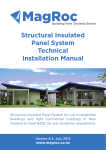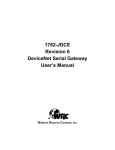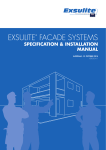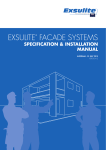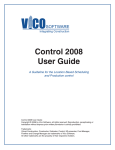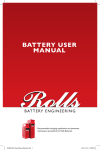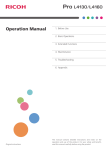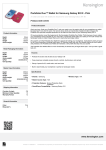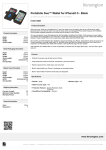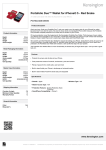Download Installation Manual - ECO ICF Builders, Sunshine Coast Building
Transcript
Installation Manual 2011 Technical Installation Manual For ECO Block Insulated Concrete Walls ECO Block Pty Ltd Customer Service: 1800 669 696 Technical Support: 1800 669 696 Web: www.ecoblock.net.au 1 Installation Manual 2011 CONTENTS PAGE Part 1: About this Manual P.3 Part 2: What Eco Block can be used for P.4 Part 3: Estimating Labour P.5 Part 4: Product Specifications P.6 Part 5: Installation Guide P.7 5a): Installing the 1st Course P.7 5b): Installing the 2nd Course P.10 5c): Adjusting heights and levels P.14 5d): Installing row 3 P.14 5e): Installing row 4 P.14 Part 6: Installing Window & Door Formwork (examples 3 – 4) P.16 Part 7: Installing Braces P.19 Part 8: Installing Top Row P.21 8a): Install Wall Inserts P.21 8b): Inserting Beam Pockets P.22 Part 9: Installing & Bracing T-Walls P.23 Part 10: Preparing for the Next Floor (if applicable) P.24 Part 11: Installing Radius Walls methods 1 and 2 P.25 Part 12: Fabricating and Installing Pilasters P.30 Part 13: Pre-Placement Checklist P.31 Part 14: Placing Concrete into ECO Block ICF Walls P.32 Part 15: Internal Compaction Correct Concrete Mix Design P.33 Part 16: Attaching Internal Wall Frames P.37 Part 17: Waterproofing External Walls & Window details P.38 Part 18: Installing Electrical & Plumbing Services P.40 Part 19: Attaching Internal Linings P.42 Part 20: Attaching External Renders and Cladding P.43 Part 21: Material Safety Data Sheet. P.44 2 Installation Manual 2011 Part 1 ABOUT THIS MANUAL This Technical Manual is designed to help the Architect, Designer, Contractor, Installer and Owner Builder to construct with the ECO Block Insulated Concrete Walls System in accordance with proper construction techniques and specification requirements. This manual assumes that generally accepted construction practices (i.e. level, plumb and square) have been employed when building with the ECO-Block Insulated Concrete Walls System. Structures built with the ECO-Block Insulated Concrete Walls System should be designed, engineered, and constructed in accordance with all applicable building codes and regulations. DISCLAIMER In keeping with ECO-Block Pty Ltd (Eco-Block) policy of continuing research and development, we reserve the right to change or modify the contents of this manual at any time. It is the responsibility of the end user to obtain the most recent information available. Since ECO-Block has no control over installation or workmanship, no responsibility for results is expressed or implied. ECO-Block Insulating Concrete Form System and any other marks, drawings, or symbols are the trademarks of ECO-Block. 3 Installation Manual 2011 Part 2 WHAT ECO BLOCK CAN BE USED FOR Eco Block can be used in the following applications; House Construction Multi Unit Construction / Fire walls Projects with difficult sites Footings Curved walls Commercial Construction Retaining Wall In ground tanks Swimming Pools Basements Fences / Sound barriers Building with Eco Block is fast, cost efficient and energy efficient. Eco Block reduces the five steps used in conventional frame construction into one simple system providing: Structure Insulation Vapour barriers Sound barriers Fire walls Fastening strips Eco Block forms stay in place. The result is an energy-efficient, air tight building with greater comfort, since the foam panels act as an air and vapour barrier in addition to adding insulation. This saves heating and cooling cost as well as reduce HAVC sizing by 30 to 40% and costs. Your project is stronger too, with excellent fire-resistance, wind resistance and seismic strength. Concrete cures longer and better in all weather due to the Eco Block design. Building interiors are more comfortable, with less temperature variation, less noise and better indoor air quality. Eco Block is perfect for schools, fire walls, hotels, units and town houses and theatres. 4 Installation Manual 2011 Part 3 ESTIMATING LABOUR To achieve optimum efficiency when building with ECO Block an ideal crew will include one experienced person (who understands level, plumb and square) and two labourers. We are often asked “what does it cost to install ECO Block?” We have been involved with many projects and based on these, have developed the following guidelines. We always assume that the footings or concrete slab are in place, level and ready to accept the first course of forms. These rates also assume a standard height of 2.4m. The labour rates allow for assembly and installation of the forms, installing and stripping the bracing system, placing re-bar and pouring the concrete, and cleaning the site. Below Grade Walls: (basements etc) Guidelines vary from .07 too .1 man-hrs per .0929 square meter of wall Above Grade Walls: Guidelines vary from .09 to .1 man-hrs per .0929 square meter of wall Above grade wall guidelines are higher due to the fact that there is usually more window and door openings as well as more climbing required. We are happy to provide estimates of quantities for your projects, these will also provide a guide to Materials Supplied by others i.e. concrete volume, steel and an indicative labour rate based on the specific detail of your projects i.e. corners and t-walls. 5 Installation Manual 2011 Part 4 PRODUCT SPECIFICATIONS ECO Block2000 - Dimensions and Characteristics 101mm Cavity Block 152mm Cavity Block 203mm Cavity Block Block Dimensions (Standard Block) 1219 x 406 x 229mm 1219 x 406 x 279mm 1219 x 406 x 330mm Concrete thickness 101mm 152mm 203mm Concrete volume per Block 0.05 cubic m 0.07 cubic m 0.1 cubic m EPS Thickness (total) 127mm 127mm 127mm Wall Surface area per Block 0.5 sqm 0.5 sqm 0.5sqm Fire Rating 2 hours 4 hours + 4 hours + Sound insulation DNTW + CTR 42 DNTW + CTR 54 DNTW + CTR 54+ Thermal Insulation R-3.78 0.26 R-3.78 0.26 R-3.78 0.26 90 deg corner Block dimensions Long side 813mm Short side 406mm Long side 813mm Short side 406mm Long side 813mm Short side 406mm 6 Installation Manual 2011 Part 5 INSTALLATION GUIDE This Installation Guide is based on accepted methods and practices constructing with ICF’s over many years. If you have any concerns regarding your particular building you should seek clarification from your Eco Block supplier before you start. Footings & Slabs Prior to constructing with ECO Block, it is assumed that slabs and footings are in place, and in accordance with the Engineers design for your particular project. Your engineers design will ensure the slab is code compliant and determine the steel placement. Use the grid aid (example 1) on the following page to determine the placement of your starter bars, this will ensure they are aligned with the ECO Block connectors and save you time constructing with ECO Block. Choose an experienced and reputable concreter for the footings and slab to ensure that it is level (within .3mm to .4mm). This is very important when the first course of blocks is laid. A level footing or slab will eliminate any requirements to shim or shave the ECO Block later to achieve a level wall. Note: Formed footings are more accurate a) Installing the First Course 1. Check that Footing and Slab are clean, level and square 2. Check that Chalk lines are accurate and complete, all chalk lines should be set to the inside face of the new wall. 3. Mark out all window and door openings on the chalk line/ work surface 4. Window and Door Formwork needs to be ready before you start laying blocks. Begin to build the formwork for the doors & windows and other openings. Formwork can also be pre built and delivered to site. Having this ready will ensure much faster installation. 5. Assemble the Eco Block and stack on site as per example below. 7 Installation Manual 2011 Example 1 8 Installation Manual 2011 6. Start by placing the Eco Block corner blocks (left or right) first and align with chalk line. 7. From the corner blocks, begin to place straight blocks and attach tightly together end to end with wire tie or with plastic zip tie. 8. When the opposite end of wall is reached, place the appropriate corner block. Its important that the blocks “stagger stack” (the corner blocks are in pairs lefts and rights to help you with this). 9. Where ever possible create lapped joints, as they are stronger. You can use butt joints, but they may require extra reinforcing pre pour. (butt joints do not need to be cut on a line, lapped joints must be cut straight and where possible on a line) 10. Once the first row is complete, install horizontal rebar as per engineering specification. 9 Installation Manual 2011 b) Installing / Preparing the second course 1. Start row 2 at same end that you started with row 1, use the other corner block that you started with on row 1. (They should be in pairs 1 left and 1 right to stagger the joints) 2. Then place the straight blocks in line with the corner block, the webs should line up. 3. Use wire tie or plastic zip ties to connect rows 1 and 2 together on the third web along and the first and third web for every corner. 4. Once the second row is complete, install the horizontal rebar as per plan or engineers report. 5. Check top of second course to confirm level footings. Shim and /or trim to level as needed. 6. When the wall is level, align the wall to the chalk lines and bond to the footings/slab with Eco Block Low expansion foam every .400mm both inside and outside wall. (Insert tip of gun nozzle into the cavity under the block to let the foam glue fill about 50mm of space). Bond one side and let it set before bonding the other side to ensure the wall stays straight 7. Remember that course 1,3,5,7 and courses 2,4,6,8 are all the same pattern for stacking. Once you have the first two courses stacked this becomes the blueprint for each next course. Please refer to example 2 on the following page. 10 Installation Manual 2011 Example 2 11 Installation Manual 2011 12 Installation Manual 2011 13 Installation Manual 2011 c) Adjusting Heights and Levels After the second course is set and the rebar placed, it is time to adjust the wall if the footing is not level. If it is accurate and level, that’s great! TOO HIGH – trim the bottom of the first course block with a keyhole saw and fill void with low expansion foam adhesive TOO LOW 1. Cut EPS wedges/shims from scrap block and use to level wall. Use low expansion foam to fill voids 2. Screw into the 2 ½” track at spot form needs to be levelled 3. Use an EPS shim on the opposite side 4. Use low expansion foam adhesive to fill voids NOTE: ALWAYS USE LOW EXPANSION FOAM ADHESIVE FOR VOIDS UNDER FORMS. As this prevents concrete leakage during the pour. d) Installing Row 3 1. Start at the same corner as row one and lay blocks out along the wall. All joints should line up with the joints in row 1. 2. Use Zip ties to secure the short side of the corner block to the standard block. 3. Install horizontal rebar as per plan or engineers specification. e) Installing Row 4 1. Start at the same corner as in row 1, laying the blocks out along wall to the end 2. All joints should line up with those in row 2 3. Use zip ties to secure the short side of corner blocks to the straight blocks 14 Installation Manual 2011 4. If a block needs to be cut, they should be the same size as those cut for row 2 5. Install horizontal rebar as per plan or engineers specification. If you are building a second story with Eco Block, make sure to leave enough vertical rebar extending up to continue building as you did with level 1. Normally .600mm or as specified by the Engineer beyond the top of the wall to maintain the minimum lap requirements. Refer to example photo above. Refer to the installation DVD which will show further details, this will also have CAD Files and PDF’s for all other sections too Use Caution when using plastic zip ties to secure the joints between blocks as too much tension can distort the wall. When properly tightened, there should no more than .3mm of inward deflection off the connectors. Technical Tip: Keep vertical bar 8mm from the top of wall, also remember to maintain your minimum rebar overlap requirements as per your engineering drawings. 15 Installation Manual 2011 Part 6 INSTALLING WINDOWS & DOOR FORMWORK refer to examples 3 – 4 1. Establish the bottom of opening / formwork and mark on blocks 2. If the outside edge of the formwork lines up on a web, you should alter the web pattern or simply slide the formwork over 3. Cut the blocks to accept the formwork 4. Where needed install vertical rebar into spaces under the formwork locations 5. Window formwork should be built with access points in the bottom to allow for the concrete to placed through the formwork into the wall. 6. Place the formwork into position and secure to the wall. The formwork does not need to line up with cut lines on the forms as any spaces can be filled between the wall and the formwork before the pour 7. Build Eco Block up to and around the formwork 16 Installation Manual 2011 Example 3 17 Installation Manual 2011 Example 4 18 Installation Manual 2011 Part 7 INSTALLING BRACES 1. When laying the bracing out ready to install, keep in mind how it will need to safely support scaffold planks. 2. On each inside corner you should have at least one brace. Approx .400 off the corner / lining up with webs 3. Attach strong backs to the wall using #10 gauge screws through the top of the slots into the webs, one screw to each row of Eco Blocks. Keep the screws loose enough to slide in the slot. Do not use tapping screws. The strong backs should line up plumb with cut lines on the forms to ensure they will line up with top row webs. 4. Attach one turnbuckle and scaffold bracket to each strong back and check to make sure that it is high enough to support the concrete placement. If not try another set of holes in the strong back. 5. Install all turnbuckles at same height. 6. Attach turnbuckles to ground slab or floor (not less than 45 degrees, extended if needed) 7. Install all scaffold brackets. 8. Place planking and secure in place. 9. Install guard rails as required, sign hazards at head height to prevent accidents 10. Plumb all corners and install a string line at the top of the wall along the outside edge. Slide a .20mm spacer block between the string and the blocks at each corner. Slide .20mm spacer block along wall and adjust the plumb of the wall with the alignment turnbuckles as you move along the wall from corner to corner. 11. Just before concrete placement it is good practice to adjust the top of the wall in about 10mm. Leave the corners plumb. 12. During concrete placement monitor the string line, if the wall moves toward the string have someone adjust it back. 13. Immediately after concrete placement, re-align walls using the string, blocks and turn buckles 19 Installation Manual 2011 Tip: Remember it’s easier to push a wall out than it is to pull the wall in. REFER TO EXAMPLE 1 20 Installation Manual 2011 Part 8 INSTALLING THE TOP ROW 1. Determine where the lintels are prior to laying blocks in place 2. If needed, place the lintel rebar on top of window and door formwork to allow the correct amount of concrete flow around the rebar as required by code 3. Start at the same corner as row 1 and lay the blocks out along the wall 4. Use zip ties to hold the forms together horizontally at every vertical joint 5. Use zip ties to tie short corners to the standard panel 6. Install service penetrations as required. a) Installing Wall Inserts Place a sleeve for anything that needs to pass through the wall, such as: • Water, electric, phone, CATV and gas service • Sewer connection • Pipe for outdoor spigots • Dryer vents Use a length of PVC pipe longer than the width of the wall for easy placement. The diameter of hole for the PVC pipe should be slightly larger than what will be placed through it, use a hole saw for this. Glue the pipe in place using low expansion foam. Fix a piece of temporary ply over the ends if the sleeve, by screwing into the webs in the blocks. After the pour is complete and the concrete set you can remove the ply and bracing Trim the excess length of PVC flush with the forms. 21 Installation Manual 2011 b) Inserting Beam Pockets Determine the beam elevation using a laser level and mark the height on the interior of both walls 1. Measure the beam dimensions and add 2cm all around (to facilitate the placement of beam), then mark on wall next to the height dimension 2. On the inside walls, cut an opening on inside and outside panels for the beam placement after the pour 3. On the outside walls, only cut out the foam from inside of the block 4. Brace opening with 19mm plywood screwed into the plastic webs in the block 5. If a bearing or weld plate is specified, insert this, after concrete has been poured but is still wet and workable 6. Be sure to allow for the depth of bearing plate, when measuring beam elevation 7. Install vertical rebar as per plan or engineers specification. 22 Installation Manual 2011 Part 9 INSTALLING & BRACING T-WALLS Every course of the “T” wall must have a continuous horizontal 1 meter length of rebar at the proposed Tee. A pre bent 90 degree rebar is also required at every course 1. Complete the first course of the “T” continuous wall. 2. Use a felt-tip marker to mark the through wall where the Tee wall will but against it. 3. Remove the foam from the “T” wall where the Tee intersects but only to the thickness of the concrete core, then butt the first course of the Tee up against the wall. 4. Tie the first Tee wall web to the rebar in the “T wall” using a zip tie or a wire tie. Additional exterior support with ply and braces should be installed as required on every course including on the exterior as in the example Continue to build the wall following these steps on every course. When the entire wall has been checked for plumb and square, apply foam adhesive to the entire butt joint. Another way to build a “T” wall is to construct the entire through wall first. This requires pre-planning to ensure there is adequate reinforcement at every course to allow the Tee wall to be attached securely. All other steps above then need to be applied. Example 9 Example 10 23 Installation Manual 2011 Part 10 PREPARING FOR THE NEXT FLOOR (IF IT HAS BEEN SPECIFIED IN ECO BLOCK) If ECO Block is being used for the next level of structure, the top of the outside panel of the block should be covered to protect from concrete spillage during the slab pour. Install the Rebar dowels ready for the first course and then install the service penetrations. When placing the concrete, remember to leave a portion of the web exposed as this will allow you to tie the next row down when you continue building with ECO Block. 24 Installation Manual 2011 Part 11 HOW TO PREPARE AND INSTALL A RADIUS WALL There are several ways to effectively fabricate a curved or radius wall. Correctly bracing, reinforcing, and the placement of concrete are the responsibility of the contractor. All radius dimensions are on the outside face of the ECO-Block wall. CURVED WALL METHOD 1: HOT KNIFE 1. Determine the radius of your wall and mark on the slab, indicating the start and end of the radius. 2. Install 100mm pieces of starter channel on the radius line and secure them to the concrete approximately every 400 o/c. If you have flexible steel stud track a continuous track on the radius line is preferred. 3. Cut lengths of 5mm ply to 200mm with a skill saw 4. Cutting the blocks, use the webs as a guide, make relief cuts between the webs on the inside of the exterior panel, with a hot knife. There should be two relief cuts in the panel between the webs and the one at each end of the panel outside of the last web. For smaller diameter radius wall make a 50mm relief cut and a larger radius wall make a 30mm relief cut. 1. Using the webs as guide, make relief cuts between the webs on inside or exterior panel with skill saw. 2. Assemble the exterior panels with the relief cuts and the interior panels. It is recommended to use three connectors per web at Tee locations 1, 3, and 5. 3. Fabricate the wire cutter for the hot knife so the corresponding dimensions (see Table 1) will be cut from the inside panel for the given radius. X dimension is closest to the plate; Y dimension is at the tip. 25 Installation Manual 2011 NOTE: Allowances need to be made for the additional melting from the wire so the exact dimension is cut from the foam. This is best done by making a test cut with the hot knife on a scrap piece of ECO-Block to ensure you measurements are correct prior to cutting the blocks for the radius wall. TECHNICAL TIP: Care should be taken to ensure that the wire is not bent inward (concaving) as there will be a resulting curve in the block panel and the pieces will not fit together flat. A slight bend of the wires outward will allow the resulting pieces of block to fit flat together with no resulting gaps. 4. At each midpoint between the webs on the inside panel, run the hot knife through the entire height of the form. When cutting the ends of the blocks, it is best to place the adjoining blocks together and make the hot knife cut with the panel edge of each block in the middle of the hot knife cut. NOTE: The material removed should be slightly pie shaped. 26 Installation Manual 2011 5. Place the exterior panel of the block at the start or the track which is fastened to the concrete slab. 6. Pull the cut pieces together and fasten the 200 mm ply strips to the inside panel face with drywall screws, flush with the bottom of the first course. 7. Ensure that the pieces are held together tight and aligned at the top prior to fastening. 8. Place the adjoining blocks in place and fasten ply as in the above step. Note: Overlap the end of the hardboard strips where necessary to ensure a continuous connection. When cut properly, the inside panels should fit tight together and leave no gaps. If small gaps are present, they should be filled with low expansion foam once the forming of the radius is complete and prior to concrete placement. 9. Place the next course of blocks on top of the first course in a running bond pattern ensuring that the webs and connectors are all vertically aligned. 10. Fasten the Ply strips so they overlap the horizontal joint between first course and the second course. 11. When the fourth course of block is in place, Install the bracing/scaffold system and check for vertical level, adjust as required. 12. Continue stacking the blocks repeating the above two steps until the desired wall height is attained. Then install the 200mm ply hardboard on the exterior at every course to course horizontal joint. CURVED / RADIUS WALL – METHOD 2 1. Cut assembled ECO Block into 203mm increments with the web at the centre of each increment. 2. Mark the inside and outside diameter of the curved wall on the footing or slab. 27 Installation Manual 2011 3. From the centre of the circle, snap a radius line to the outside diameter line. This becomes the centre radius for the next step. 4. On the outside diameter line, snap a radius 102 mm on each side of the centre radius. 5. Place a 203mm cut block section with the web on the centre radius. Line up the outside corners of the block section with the outside radius lines. 6. Mark the form section at the outside radius lines, and cut angles accordingly. 7. This block now becomes the template to cut the other sections. Mark and cut all block sections accordingly 8. Zip ties, tape or foam can now be used to connect all the form sections into the wall. Repeat the steps for each course of the radius wall. 9. This process will result in vertically stacked joints, add additional formwork support where required, use the 200mm ply strips for this prior to concrete placement. 28 Installation Manual 2011 29 Installation Manual 2011 Part 12 FABRICATING AND INSTALLING PILASTERS Pilasters can be assembled from ECO-Block to provide support for lateral pressure or to provide load-bearing structural support. They are commonly used to provide a break in long, straight wall runs to give them additional vertical support. Pilasters can also be specified in below grade walls to compensate for backfill pressure. Pilaster size and footing depth must be designed, engineered, and constructed in accordance with all applicable building codes and regulations. A typical pilaster to compensate for backfill pressure can be built using the T-wall method, 90º panel connectors, and cut pieces of panels to make the end cap. All pilasters must be braced and supported similar to T-walls. (Refer to Bracing section for further details. 30 Installation Manual 2011 Part 13 PRE-PLACEMENT CHECKLIST Check off all of the details on this Pre Placement checklist before the commencement of concrete placement Pre Placement checklist Item Done Does the layout match the plan everywhere? Are the walls plumb everywhere? Are the walls square? Do you have a concrete vibrator with a 2.5mm head ready to go? Is the top of the wall level? Have all braces been fixed to every course of Eco Block, and to the ground? Have all the planks been secured to the brace? There must be enough planks to allow the boom pump operator to walk around the whole building without getting down. (This may not always be possible) Is all window/door formwork in place, level, plumb and square? Polystyrene formwork must all be glued in with low expansion foam, has it been checked? Is all window/door formwork diagonally braced against racking? Have all cuts and potential weak spots been reinforced? Use strips of form ply and screw to webs. Are all penetration sleeves in place and glued securely? Are all anchor bolts for interior walls fixed in place? Are all vertical bars in position and tied securely? Are all beam pockets installed? Is the ledger or ledger connections (if any) in place and securely fastened? Do you have enough anchor bolts or straps on hand for the top of the wall? Have you planned out the position of the anchor bolts or straps (if any) at the top of the wall? Have you marked the spots for the anchor bolts? Do you have enough squares of plywood or scrap 19mm form ply to screw over the wall to reinforce weak spots and bulges? Are all vertical bars in position? Are all lintels properly reinforced and propped from below? Has your engineer inspected the wall and given his approval? Is the job site clear for the operation of the concrete truck, pump (if any) and the crew that will be on the ground? Has the concrete been ordered and quantity verified? Has the pump (if required) been ordered? Is there good access for the pump truck and concrete truck? Check and make sure that there are no overhead power lines. 31 Installation Manual 2011 Part 14 PLACING CONCRETE INTO ECO BLOCK ICF WALLS Concrete Volume Calculation After the wall is built and ready to pour, re-estimate the amount of concrete that you will need. Do not rely on the original estimate. The layout may have changed. A quick way to re-estimate the number of cubic meters of concrete needed is to count up the number of blocks in the wall, and divide: 230Series 100mm conc core Divide by 20 One cubic meter fills 20 blocks 280 Series 150mm conc core Divide by 14 One cubic meter fills 14 blocks 300 Series 200mm conc core Divide by 10 One cubic meter fills 10 blocks You can also use the Eco Block estimator on our website: www.eco-block.com.au to confirm your calculations Above-grade and below grade pours require lifting equipment like a boom pump because of its easy manoeuvrability. Order your boom pump with a line reduction to 75mm hose and with two ninety-degree angles near the end (forming an "S") or a loop attachment as both of these slow down the flow of the concrete. Line pumps are smaller, and often less expensive. Order one of these with an 80mm line or less. You will need 1-2 workers on the ground during the pour to help move the line. If you are using steel or plastic fibres in the concrete mix it is preferable to use a 100mm diameter line pump or boom pump 32 Installation Manual 2011 Part 15 INTERNAL COMPACTION AND CORRECT CONCRETE MIX DESIGN All concrete placed in Eco Block formwork needs to be compacted. That is, it needs to fill every part of the wall to ensure there are no voids and that the rebar is properly embedded in concrete. There are three ways to achieve compaction: External vibration Internal vibration Hand prodding Although all three methods are acceptable with the appropriate concrete mix, for the purpose of this manual we will concentrate on internal vibration. Correct Concrete Mix Design A common problem associated with concrete placement is improper mix design. In general, people look at cost before quality when evaluating mix designs, without the understanding that a small extra cost in mix design can reduce your labour cost on site. Working closely with your concrete supplier will result in a mix design that will work well. ECO Block cannot provide this mix design because the ingredients in concrete will vary from region to region throughout Australia, but it is not uncommon to see a proper mix design provide time / labour savings, and result in better walls with less concern for compaction. What to look for in your mix design 130 to 150 slump Using the ideal slump of concrete is the best way to ensure that your wall is free of voids. Tests conducted by the Portland Cement Association clearly demonstrate that a 130 to 150 slump, 25 mpa and using an internal mechanical vibrator are found to provide adequate compaction / consolidation (PCA R&D Serial No.2656). Correct Aggregate Size From our experience the following aggregate sizes work best with the following wall thickness: Eco Block Wall 100 series wall (101mm) Aggregate Size 7 to 10mm 150 series wall (152mm) 10mm 200 series wall (203mm) 10 to 15mm Some aggregate sizes may not be available in all regions. If this is the case in your area and your concrete supplier understands your needs, they may be able to design the mix around the available aggregate sizes. 33 Installation Manual 2011 Lintels Due to the high rebar congestion in lintels, to ensure minimal voids in this sensitive area it is best to use internal vibration to get the best compaction. “Self Compacting Mix” A self compacting mix may be achieved in different ways depending on your region. In some parts of the country this can be achieved with concrete add mixtures, while in other parts it may be with more cement content and in some areas they may add more fly ash. It is important to note that AS3600 does not have any provision for “self compacting concrete”. A “Pump” Mix Your mix design should take into account whether a pump will be used. Using the proper concrete mix with your concrete pump will result in shorter and more successful pump jobs, which in return will lower your costs on site. Engineers Specification It is important that you follow the concrete specification as set by the Engineer. Internal Vibrators Internal vibrators come in different shapes and sizes. The Head Head sizes can be anywhere from 2cm (3/4”) to over 10cm (7”) in diameter. Do not put an oversize vibrator head into an Eco Block wall. Due to the narrowness of Eco Block walls, we recommend using a head size of 2.5cm (1”). The Motor Motor size is critical for Eco Block walls and is measured by horsepower. Eco Block recommends a 1 horse power motor. The Shaft The shaft is the part of the internal vibrator that connects the head to the motor and comes in many different lengths. When you are looking for an internal vibrator keep in mind the different heights of walls you may be building and get a shaft that will reach well down into the wall Proper use of your internal vibrator The most effective consolidation will occur when you have an understanding of what you are trying to accomplish. The objective is to get the entrapped air out of the wall as well as compaction. The only direction that entrapped air can travel is up. Therefore, it is best to insert the head of the internal vibrator into the fresh concrete: “fast in – slow out”. In most cases inserting your internal vibrator between every two webs will do an excellent job, but watch your mix. If the concrete begins to stiffen you may need to internally vibrate every web. 34 Installation Manual 2011 Recommended Concrete Placement and Compaction as follows: 1. Place the first lift of concrete (lifts can be anywhere from 1m to 1.2m) 2. Compact the first lift of concrete 3. Place the second lift of concrete 4. Consolidate second lift of concrete (insert internal vibrator so it breaks into the previous lift) 5. Repeat this process until wall is complete Remember, it is up to the person placing concrete to recognize when concrete is of a proper slump and at what height the lifts should be. Sources Portland cement Association R&D Serial No. 2656 Allen Engineering If, the engineer or architect on the job specifies another mix design, follow their specifications. Photo: Concrete pour with a boom pump. 35 Installation Manual 2011 Concrete Placement 1. Establish your crew and give clear directions as to who is responsible for what; • One person to place concrete (pump operator) • Two people to consolidate concrete • One or two people to level the wall 2. Tell the operator how many lifts you will be doing and what slump concrete you want. Lifts of 1 to 1.2 meters is moderate and allow 20 minutes per pour approx. 3. Place the concrete at least 400mm from a corner (never into a corner as it could move the wall). Flow the concrete through the corner. 4. Create a lift of concrete on either side of the corner before filling the corner. The lifts on either side of the corner act as an anchor holding the corner in place. 5. Windows filled from one side and let the concrete flow under the window formwork. Stop the pump and move to the opposite side of the window and continue. Some windows will require extra concrete to be placed into the opening at the bottom of the formwork. 6. Consolidate concrete during each lift. 7. Monitor walls during and after concrete placement and then adjust turnbuckles to level the walls. 8. Install anchor bolts if required for roof truss fixing. 9. Ensure concrete placement at windows and doors is consolidated by hitting the face of the formwork with a hammer or slap with a 100/50 piece of timber. 10. Clean all concrete off slab, walls, braces and tools when placement is finished. 11.Before you leave check to ensure your walls are straight and plumb. 36 Installation Manual 2011 Part 16 ATTACHING INTERNAL WALL FRAMES Attaching interior frame walls to the exterior ECO-Block walls can be accomplished in a number of ways. Method 1: Prior to concrete placement, locate the interior walls. Insert the proper anchors through the foam and into the concrete core. Upon concrete placement, the anchors will be embedded into the concrete core. Method 2: If the interior walls happen to fall in line with one of the webs that are located at 203mm centres, simply screw the stud to the web with a coarse thread drywall screw. Method 3: Locate the interior wall partition and remove the section of foam. By removing the foam, the treated stud can now be anchored directly to the concrete core with the proper mounting hardware. 37 Installation Manual 2011 Part 17 WATERPROOFING EXTERNAL WALLS & WINDOW DETAILS There are many different waterproofing products available. These ranges from selfadhesive membranes too spray on and roll-on products. For ECO Block they must be foam compatible. Products with solvents in them can dissolve the foam; always check with the manufacturer or distributor regarding their specific application to EPS, prior to application. 38 Installation Manual 2011 Example 12 39 Installation Manual 2011 Part 18 INSTALLING ELECTRICAL AND PLUMBING SERVICES Electrical and Plumbing Services are easily installed into the ECO-Block wall. For electrical boxes, use a hot knife, skill saw, insulation knife or router to remove the foam at the desired location. Once the foam is removed the boxes can be screwed to the webs using a standard drywall screw, or screwed into the concrete using concrete anchors and glued. Example of electrical installation & plumbing To create chase cuts in the foam for wiring, use a hot knife, router, or skill saw with a depth stop or jig saw. Angle the channel so it has a lip on the bottom to hold the cable in place, or spot glue the cable with EPS compatible foam adhesive. The chase cuts for the plumbing services can be created in the same manner. For larger lines furring out the wall may be necessary. Plumbing can be installed inside the wall cavity prior to the pour, but can create a weak spot in the wall, be sure to check with an engineer first. Technical Tip: For horizontal chase cuts it is better to make the cuts where the blocks meet horizontally as the webs are cut short at this point, making it easier to cut. 40 Installation Manual 2011 Part 19 ATTACHING INTERNAL LININGS Workers can screw plaster board and other forms f panelling to the plastic webs just as it attaches over frame construction. You can use a foam-compatible adhesive in addition to or instead of screws if you prefer. Check with your local building code if you choose to use only foam – compatible adhesive. Eco Block recommends using screws. However if you choose to nail, use ring-shank nails for a better grip. Example of fixing plasterboard Eco Block For very heavy wall-mounted fixtures (like a sink), rout out or hot knife the foam to make room for timber that can attach directly to the concrete with concrete bolts. You can then screw the fixture directly into the timber. When installing cabinets, it is a good idea to screw plywood, sized slightly smaller than the outline of the cabinets to the ECO; this provides an excellent surface for fastening the cabinets. Butt the wallboard directly up to the edge of the plywood. 41 Installation Manual 2011 . Fastener Description #10 x 38mm / #10 x 1/1/2" Pan Head SelfTapping Screw #10 x 32mm / #10 x 1/1/4" Hex head sheet metal screw #8 x 38mm / Pan Head Self-Tapping Screw #10 x 32mm / #10 x 1/1/4" Pk.Hd Self Tapping Screw #6 x 38mm / #6 x 1/1/2" Pan Head Self Tapping Screw #10 x 32mm / #10 x 1/1/4" Bugle Head HiLo Screw #6 x 32mm / #6 x 1/1/4" Bugle Hd Drywall Screw (15tpi) Pull Out Test (lbs) / KGs Med Avg Max Min (288) (305) (640) (200) / / / / 130kg 138kg 290kg 91kg (285) (290) (362) (230) / / / / 129kg 131kg 164kg 104kg (258) (284) (550) (175) / / / / 117kg 128kg 249kg 079kg (275) (276) (315) (220) / / / / 125kg 126kg 143Kg 100kg (233) (260) (510) (175) / / / / 106kg 118kg 231kg 79kg (262) (249) (296) (183) / / / / 118kg 113kg 134kg 83kg (212) (210) (240) (179) / / / / 96kg 95kg 109kg 81kg Shear Results Med Avg (514) (516) / / 233kg 234kg (460) (447) / / 209kg 203kg (427) (428) / / 194kg 194kg (544) (555) / / 247kg 253kg (344) (358) / / 156kg 162kg (489) (487) / / 222kg 221kg (352) (349) / / 160kg !58kg Max (770) / 349kg (505) / 229kg (454) / 206kg (681) / 309kg (521) / 236kg (525) / 238kg (422) / !91kg Min (390) / 177kg (326) / 148kg (398) / 181kg (458) / 208kg (292) / 132kg (446) / 202kg (264) / 120kg 42 Installation Manual 2011 Part 20 APPLYING EXTERNAL RENDERS AND CLADDING Any nailed or screwed exterior cladding (plastic, vinyl, timber, steel and cement sheets) attaches easily to the webs built into the ECO Block Panels. We recommend screwing with #10 course thread screws. Consult the manufacturers of the cladding for specific installation instructions. ECOBlock can accommodate an acrylic-based render product. Acrylic renders are typically reinforced with fibreglass mesh. Acrylic renders are also durable and resist cracking in both hot and cold climates. For the proper installation requirements, consult the manufacturer of the render product you choose. Below grade, use water proofing just as you would over a conventional basement. Self-adhesive membranes work well as do spray-on and roll-on products, make sure they are foam-compatible. Very Important Products with solvents in them can dissolve the foam, so check with the manufacturer or distributor of the waterproofing product concerning application to EPS, prior to application. Please refer to the installation video for more examples. Additional Professional Design Details are available from ECO-Block Distribution Pty Ltd. Please contact your local Distributor or Eco-Block 1800-669-696. 43 Installation Manual 2011 Part 21 MATERIAL SAFETY DATA SHEETS TECHNICAL DATA INFORMATION NATIONAL POLYSTYRENE SYSTEMS RIGID CELLULAR EXPANDED POLYSTYRENE EPS or Expanded Polystyrene ~ Expanded polystyrene is an inexpensive, versatile, light weight cellular plastic material made up of fine spherical shaped cells which are comprised of 98% air. This air is trapped within the closed hollow cells of the particles forming a strong stable material. EPS has a very high strength to weight ratio which, dependent of the density of the material, offers exceptional compressive and flexural strength, and dimensional stability characteristics. Where it comes from ~ EPS is manufactured from Expandable Polystyrene bead, which are particles of polystyrene polymer containing a CFC - Free expanding agent. This raw expandable polystyrene is manufactured from Styrene Monomer. Styrene monomer is manufactured around the world from by-products of the production of gas, petroleum, and steel. The chemical composition of polystyrene as it is manufactured is as follows: Heat & Catalyst Benzene + Ethylene Ethyl Benzene Monomer Catalytic Cracker Styrene (+H2 Extracted) + Initiator (In) Heat Polystyrene Styrene Monomer +In + Additional Styrene Monomer How it is manufactured ~ The expandable polystyrene is softened by heating with steam causing hollow cells to be formed within the particle due to the blowing or expanding agent (normally pentane). This expansion causes the raw bead particles to expand up to 50 times their original volume. Blocks of EPS are manufactured by resoftening the expanded bead with steam and fusing them together under pressure in a mould. These blocks are then cut with hot wires to form sheets and profiled shapes. Shaped EPS is manufactured by fusing softened beads in specially designed moulds. 44 Installation Manual 2011 TECHNICAL INFORMATION PHYSICAL PROPERTIES ~ National Polystyrene Systems (NPS) E.P.S range comprises block moulded and shape moulded expanded polystyrene products. NPS block foam is manufactured to AS1366 Part 3 ~ 1992 and contains a flame retardant. The minimum physical properties specified in this standard are the minimum requirements to which NPS foam complies, however if physical properties outside this standard are required, a tailor made class of NPS foam can be designed to meet these requirements. The nominal densities used to manufacture expanded polystyrene are as listed in the standard; however the physical properties may be achieved using other densities, depending on raw material and other variables. The table below lists the minimum physical properties of NPS foam as it compares to AS1366 Part3 ~ 1992. 45 Installation Manual Physical Property Average Density Identification Colour per AS1366.3 Compressive strength at 10% deformation (min). Cross breaking strength (min). Rate of water vapour transmission (max) measured parallel to rise Dimensional stability (max) Thermal resistance (min) at 25 degree C.(50mm Sample) Thermal Conductivity (min) at 0 degree C. (50mm Sample) Flame propagation: median flame duration eight value (max) median volume retained eight value (max) Unit Class Test method used to measure compliance --- L SL S M H kg/cum Colour 11 Blue 13.5 Yello w 16 Brow n 19 Blac k 24 Green 28 Red kPa 50 70 85 105 135 165 AS2498.3 kPa 95 135 165 200 260 320 AS2498.4 ug/m2s 710 630 580 520 460 400 AS2498.5 % 1 1 1 1 1 AS2498.6 1.13 1.17 1.20 1.25 1.28 AS2464.5 or AS2464.6 1 m2K/W 1 VH 2011 W/mK 0.039 0.037 0.036 0.03 5 0.034 0.032 s s % % 2 3 15 12 2 3 22 19 2 3 30 27 2 3 40 37 2 3 50 47 2 3 18 15 AS2122.1 46 Installation Manual 2011 FLOATATION PROPERTIES ~ The density of NPS Foam is low compared to water, with a nominal density range from 13 to 28 kg/m3 compared with water at 1000 kg/m3. The water buoyancy per cubic meter of NPS Foam is determined by subtracting its kg/m3 density from 1000. The result is the weight in kilograms, which a cubic meter of NPS Foam can support when fully submerged in water. CHEMICAL PROPERTIES ~ NPS Foam is resistant to virtually all aqueous media, including diluted acids and alkalis. It is also resistant to water-miscible alcohol such as methanol, ethanol and propane, and also to silicone oils. NPS Foam has limited resistance to paraffin oil, vegetable oils, diesel fuel, and Vaseline. These substances may attack the surface of NPS Foam after long term contact. NPS Foam is not resistant to hydrocarbons, chlorinated hydrocarbons, ketones and esters. Paint containing thinners and solutions of synthetic adhesives fall into this category, and this should be taken into account in any painting or bonding operations. Anhydrous acids such as glacial acetic acid and fuming sulphuric acid destroy NPS Foam. RESISTANCE TO FUNGI AND BACTERIA ~ Fungus attack has not been observed on EPS Foam and foam does not support bacterial growth. Surface spoilage (in the form of spilt soft drink, sugar, etc) can however supply the nutrient for fungal or bacterial growth. RESISTANCE TO ANTS, TERMITES, AND RODENTS ~ Since it has no food value, NPS Foam does not attract ants, termites, or rodents. However, it is not a barrier to them. Ants, termites and rodents may chew through NPS Foam to reach food or establish a comfortable home. TOXICITY ~ The heat of combustion of solid polystyrene polymer is 40,472 kJ/kg – Combustion products are carbon dioxide, water, soot (carbon), and to a lesser extent carbon monoxide. A CSIRO report comments that the toxicity of gases associated with the burning of EPS is no greater than that associated with timber. Toxicity of thermal decomposition products of EPS appears to be no greater than for wood and decidedly less than other conventional building products i.e. Polystyrene CO=0.09 White Pine CO=0.09 plus plus CO2=0.01 Total=0.10 CO2=0.003 Total=0.09 47 Installation Manual 2011 FLAMMABILITY PROPERTIES ~ Expanded polystyrene products are combustible and should not be exposed to open flame or other ignition sources. Insulation material, as with other organic material, must be considered combustible and to constitute a fire hazard if improperly used or installed. Expanded polystyrene (Fire Grades) contains a fire retardant additive to inhibit accidental ignition from small fire sources. Please refer to the table below for a comparison of expanded polystyrene with other common building materials. Material Ignitability Spread of Heat Smoke Index Flame Index Evolved Produced Index (0-20) (0-10) Index (0-10) (0-10) Expanded Polystyrene 0 0 0 0-1 - with sizalation 450 facing Expanded Polystyrene 0 0 0 0 - sandwich panel with 0.65mm steel Expanded Polystyrene 12 0 3 5 Rigid Polyurethane Australian Hardboard - Bare - Impregnated with fire retardant (4.75mm) Australian Soft board - Bare - Impregnated with fire retardant (12.7mm) T&G Boarding (25x100) - Blue gum - Oregon Plywood, Coach wood veneer (4.75mm) - Bare - Impregnated with fire retardant 18 10 4 7 14 0 6 0 7 0 3 7 16 4 9 0 7 0 3 7 11 13 0 6 3 5 2 3 15 12 7 0 7 3 4 5 48 Installation Manual 2011 Material Safety Data Sheet NPS Expanded Polystyrene MATERIAL DETAILS UN No. none HAZCHEM none CAS RN none DG Code none Pois Schedule none USAGE As a packaging material or for the thermal insulation of buildings. INGREDIENTS CAS RN none Name or Description Polystyrene foam Proportion % major PHYSICAL & EXPOSURE DATA Physical Data Molecular Weight Boiling Range at 101.3 kPa(C) Melting Range (C) Specific Gravity (water=1) Vapor Pressure (kPa) Relative Vapour Pressure (Air=1) Volatile Component (%Vol) pH (1% Aqueous solution) : : : : : : : : Not applicable >240 (Decomposes) >100 0.01 - 0.04 Not available Not available Not available Not available Other Properties Low density, odourless solid as slab, prefoam, or beads. Totally insoluble in water. Attacked by organic solvents but resists organic acids, alkalis, and alcohols. Exposure Limits None assigned for mixture. Refer to individual constituents. TLV TWA: 10 mg/m3 - (nuisance particulate) This compound may contain residual levels of the following materials: TLV TWA: 50 ppm, 215 mg/m3; STEL 100 ppm, 425 mg/m3 - Skin (styrene monomer) TLV TWA: 600 ppm, 1800mg/m3; STEL750 ppm, 2250mg/m3 (pentane blowing agent) 49 Installation Manual 2011 HEALTH HAZARD DATA Symptoms of exposure ~ Acute and chronic effects Swallowed The solid/dust is irritating to the gastro-intestinal tract and may be harmful if swallowed. Considered an unlikely route of entry in commercial/industrial environments. Eye The solid/dust is mildly irritating and maybe abrasive to the eyes. Skin The material is regarded as non-irritating to the skin. Inhaled The dust is irritating to the upper respiratory tract. Emergency and First Aid Procedures Swallowed Swallowing is unlikely. If swallowed, obtain medical attention. Eye If in eyes, flush immediately with water for at least 15 minutes. Retract eyelids often. If discomfort persists, seek emergency medical attention. Skin In the event of abrasion or irritation of the skin seek medical attention. Inhaled Remove to fresh air. If not breathing give artificial respiration. If breathing difficult, give oxygen and obtain emergency medical attention. Advice to doctor Treat symptomatically. 50 Installation Manual 2011 PERSONAL PROTECTION and HANDLING Protective Measures Eyes No special equipment required. When cutting or sanding, safety glass maybe required. Hands / Feet No special equipment required due to the physical form of the product. However, when cutting or sanding, light weight rubber gloves maybe required. Respiratory No special equipment required due to the physical form of the product. Local ventilation recommended for hot wire cutting operations. If inhalation risk of overexposure exists, wear approved organic-vapour (smoke) or dust respirators. Other Barrier cream, overalls, eyewash unit Handling Procedures In normal use ~ No special handling procedures required. Avoid contact with incompatible materials. Avoid smoking, naked lights or ignition sources. Additional for hot wire cutting or sanding ~ Avoid inhalation of vapour or dust if inhalation over exposure risk exists, wear approved respirator. Use in well ventilated area. Wash hands with soap and water after handling. FIRE AND EXPLOSION DATA Flash point (closed cup C) ~ not available. Auto ignition Temperature (C) 480 (230 piloted ignition). Decomposition Temperature (C) >240. Lower Explosive Limit in Air (% by vol.) Not available. Upper Explosive Limit in Air (% by vol.) Not available. Extinguishing Media Water spray or fog. Foam. Dry chemical powder. Carbon Dioxide. INCOMPATIBILITY Avoid reaction with oxidizing agents, and organic solvents. 51 Installation Manual 2011 FIRE FIGHTING PROCEDURES Alert Fire Brigade and tell them location and nature of hazard. Wear breathing apparatus plus protective gloves for fire only. Prevent, by any means available, spillage from entering drains or water course. Use fire fighting procedures suitable for surrounding area. Do not approach containers suspected to be hot. Cool fire exposed containers with water spray from a protected location. If safe to do so, remove containers from path of fire. Equipment should be thoroughly decontaminated after use. Fire and Explosion Hazard including decomposition products. Combustible. Slight fire hazard when exposed to heat or flame. Dust generated from handling, cutting, or storage may form explosive mixtures with air. Heating may cause expansion or decomposition leading to violent rupture of containers. On composition, may emit toxic fumes of carbon monoxide (CO). May emit acrid smoke. May shrink, melt, or drip. STORAGE & TRANSPORT Storage Procedures Suitable Containers ~ No restrictions on type of containers. Taped bundles. Plastic bag or plastic wrap. Paper bag or paper wrap. Check that material is clearly labelled. Any stockpile should not exceed 60m3. Requirements ~ Store at ambient temperature. Store away from incompatible materials. No smoking, naked lights, or ignition sources. Protect containers from physical damage. Avoid generation of static electricity. Earth all lines and equipment. Transport Procedures No restrictions known SPILLS AND DISPOSAL Spills Minor hazard. Clear personnel and alert Fire Brigade, telling them location and nature of hazard. Prevent by any means available, spillage from entering drains and water courses. If contamination of drains or waterways occurs, advise emergency services. Recover product wherever possible. Avoid generating dust. Avoid generation of static electricity. Earth all lines and equipment. Disposal Recycle wherever possible. Consult manufacturer for recycling options. Consult State Land Waste Management Authority for disposal 52 Installation Manual 2011 DISCLAIMER In keeping with ECO-Block Pty Ltd (Eco-Block) policy of continuing research and development, we reserve the right to change or modify the contents of this manual at any time. It is the responsibility of the end user to obtain the most recent information available. Since ECO-Block has no control over installation or workmanship, no responsibility for results is expressed or implied. ECO-Block Insulating Concrete Form System and any other marks, drawings, or symbols are the trademarks of ECO-Block. 53 Installation Manual 2011 Appendix 1 Acrylic Renders Guide Manufacturer Product Supa Coat Australia Gympie Qld Novatex Pty Ltd Sydney Dulux Australia Type Application Supa Coat reinforced Render EPS Hand Trowel or mechanically/ Fibre mesh Novatex reinforced Render EPS Acratex Reinforced Render EPS Hand Trowel / Fibre mesh Hand Trowel / Fibre Mesh Eco Block does not represent the above companies. There will be local suppliers that may have a render product that will suit your application. Please ensure that you check that the product you select is compatible to EPS. 54






















































